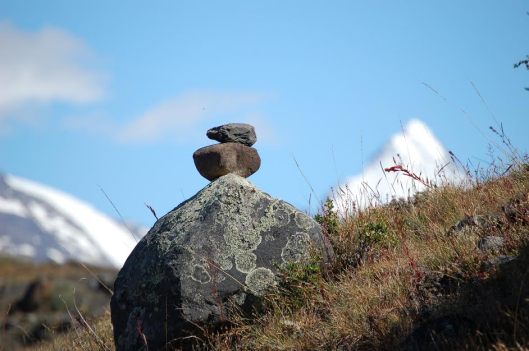Tags
One Foot Out the Door means one foot is often still in … while I started this blog to document and ruminate on my travels, I can’t step out of my regular life every day or even every month sometimes, so I decided I should also write about what’s going on inside the door on occasion.
***
In between trips right now, I’ve been on some other journeys in my mind (and I don’t mean just planning my next voyage, which is a constant activity!). I’ve been thinking about one of the things I’ve learned by wandering the world: that there are so many different ways to approach life and to get things done, and that many times those ways are not as clear or defined as we’d like them to be. Often all muddy and unformed, they can make us profoundly uncomfortable if we have a my-way-or-the-highway outlook on life. In essence, I’ve learned that on the road or at home, balance and following a middle path are not signs of weakness but are the source of strength and, ultimately, peace and happiness.

“Happiness is not a matter of intensity but of balance and order and rhythm and harmony.” (Thomas Merton)
Photo from the Herminita Peninsula, Argentina
One of these nebulous areas is the way things get accomplished in other places. On a work tour in Costa Rica a number of years ago, we were introduced to the concept of the “servant learner.” That is, we were not there to impose our methods on a small, rural community but to help, or serve, them in their work with open hearts and open minds, letting them take charge of the work and direct us in ways that may have seemed unproductive to many of us. We had to understand that we would eventually leave and that the community needed to approach its work in a way that led to self-development and self-sufficiency and not dependence on our “outside” way of doing things. It was occasionally frustrating, but dampening our own need to control things would be more beneficial to this community in the long term.
Likewise, as I’ve trekked in out-of-the-way places like Nepal, Tibet, and Peru, I’ve come to greatly admire many local guides who have steered me safely through strange lands, confusion, and even fear. Many have, at first acquaintance, appeared disorganized and unfocused to my structured, western mind, yet all have blown me away with their ability to navigate not only a trail but any problems that have arisen. They may not have handled things exactly as I would have, but their way worked on their turf; their subtle, almost invisible, way of managing seemed, at second glance, to be more powerful than the commanding type of leadership many of us are accustomed to. They bent like proverbial reeds in the wind as the situation demanded; no unyielding, mighty oak could have weathered some of the unexpected storms that cropped up regularly in the wilderness.

“Softness triumphs over hardness,
Feebleness over strength.
What is more malleable is always superior over that which is immoveable.
This is the principle of controlling things by going along with them,
…of mastery through adaptation.” (Lao Tzu)
Photo from Lhasa, Tibet
Some participants on my trips have not been able to summon this flexibility or ability to see things from a different perspective. These are the people you see yelling at guides, becoming exasperated and impatient with service workers, and refusing to let go of a personal mindset that is not doing any good as they go about a task. On top of making fellow travelers and local people upset, they nearly always succeed in ruining the trip for themselves as well. Tolerating or even embracing a different way of getting things done is not easy, and traveling and working in fuzzier ways than we’re used to can be challenging, but for me they’ve been therapeutic and mind altering.
The result is that when I get back home, the polemics and closed-mindedness that have become a hallmark of our developed society can bother me even more. Some examples of the rigidity I find hard to stomach are uncompromising partisan politics (either side), blind allegiance to some authority, and religious intolerance. We all have stances on controversial subjects, but clinging to them for dear life and shouting down our opponents feels like a mental barricade to me; wouldn’t opening the door – just a tiny crack – to another idea make for a learning experience on both sides? I like the idea of muddying up the middle, taking a little from here and a little from there and coming at solutions from both sides.

“Be soft. Do not let the world make you hard.” (Kurt Vonnegut)
Photo from Doolin, County Clare, Ireland
Some might call me naïve or just afraid of confrontation, and they may be right. But a phrase that keeps popping into my head when I think about polarizing issues these days is “the middle path.” A Buddhist teaching, the middle path (or middle way) is not something I have studied deeply and I am in no way an expert on Buddhism or this particular principle. It just seems to summarize how I feel about a lot of things; I am not wishy-washy nor indecisive nor fickle, but I don’t see any value in plunking myself down on one side of an issue and never, ever budging from it. Although the origins of the middle way were part of the path to achieve Nirvana through moderation rather than the extremes of austerity and sensual indulgence, the middle way is now seen more broadly as “… the actions or attitudes that will create happiness for oneself and others”1, or explained even more simply, “this vision is to see things as they are, rather than as we think or want them to be…” 2
I understand this best while traveling. The way things are in Costa Rica or Tanzania or many other places can be messy and frustrating (or the worst of all sins – inefficient!), but closing your mind to the local way of getting something accomplished does neither you nor others any good. The way flights are into and out of the Himalaya is sometimes they can fly and sometimes they can’t and don’t. You can sit at the airport and fume, or you can walk outside and think about how lucky you are to get a few more hours to soak up some fresh air and mountain views.

“Wandering re-establishes the original harmony which once existed between man and the universe.”
(Anatole France)
Photo of Yamdrok Lake, Tibet
One of the most fascinating, and counterintuitive, theories I studied in graduate school in Linguistics was that many societies that use and accept multiple languages tend to be more stable than those that prescribe the usage of only one national tongue. Seeing their overall population as it is, rather than how one group would like it to be, creates happiness for more than each individual group. In my part of the world, we could use some practice accepting the way some things are, not fearing the middle, muddled gray areas, and appreciating the stances and thinking that fall between the left and right, one religion and another, and so on. I wish everyone would try traveling into the middle ground sometime, and wallowing in the murky mess; it might be less comfortable and tidy than perching safely on your side, but it’s a mind-stretching, life-enhancing way to exist and – better yet – to create happiness for oneself and others.
1SGI Quarterly, July 2001, 2Buddha Space

Very well-said! I usually think of myself as fairly open-minded, but I did notice that I became quite impatient when I was in Ghana. The service seemed so unnecessarily slow to me. I realized even at the time that I was being the “ugly American” with my impatience. It’s always good to keep “the middle ground” in mind to avoid becoming someone I don’t want to be!
LikeLike
Thanks! I couldn’t have actually learned anything from all my travels without having descended into those less-than-open thoughts and behaviors myself on occasion! Ghana was really cool, though, wasn’t it? I went there with a microfinance group and was in Accra and the area around Kumasi. What were you doing there?
LikeLike
I was there for an academic conference in Accra. I added a few days for a tour of some other places, including the slave trading areas (can’t remember the names.) It was so interesting!
LikeLike
Oh yeah, I did that, too! Cape Coast castle. Very sobering.
LikeLike
This is a wonderful read! I can relate to it all. I often wonder why the world appears to be so obsessed with opinions instead of exploring and listening into the many nuanced views there can be on the same subject, theme, object etc. There is ever much to learn and see and explore, inwards as outwards. Similarly there is many a way to do the same thing (as living life for example) and as you point out, there might be more efficient ways sometimes to do thing, but at times at what cost? Worry? Stress? Exploiting this blue marble? Missing out on what is by trying to get somewhere quick?And along the same lines I also wonder why it seems as if we have to have an opinion. I find opinions quite limiting and can only in few cases see the benefit of having one (that’s my opinion on opinions lol!) I prefer to reflect upon the many possibilities and perspectives and I might then go with the perspective that resonates the most in that given moment, that lifts me up and stretches me beyond my at times limiting mind, only to surrender the perspective again and look at the next step with fresh eyes. The middle way perhaps it is a kind of return to a certain ‘innocence’.
I can see why you hold the photograph from Doolin so dear. It has much feel and atmosphere to it with a subtle beauty.
Thank you for this post, it made me reflect (as you can see) 🙂
LikeLiked by 1 person
Thank YOU for your lovely comments! Like you, I really don’t get the need to have these intractable opinions, and it seems to me that these stubborn stances seem to be increasing of late. Those Doolin rocks are not a fine photograph, but I love the way the light hits them and the way the flowers soften them.
LikeLiked by 1 person
I don’t know if these stubborn stances is increasing or if we are only bombarded more with through all the information that is available to us now through the internet.
And that is what makes a fine photograph 🙂
LikeLiked by 1 person